Composting is both a natural and cultural practice.
In wild ecosystems, expired material is decomposed and later its nutritious components are taken up by other plants. Humans have picked up on this practice, and have used it for our own benefit for centuries.
But what defines healthy compost?
You can view compost health from its efficiency in decomposing organic material – in other words, the ecosystem health within the pile itself.
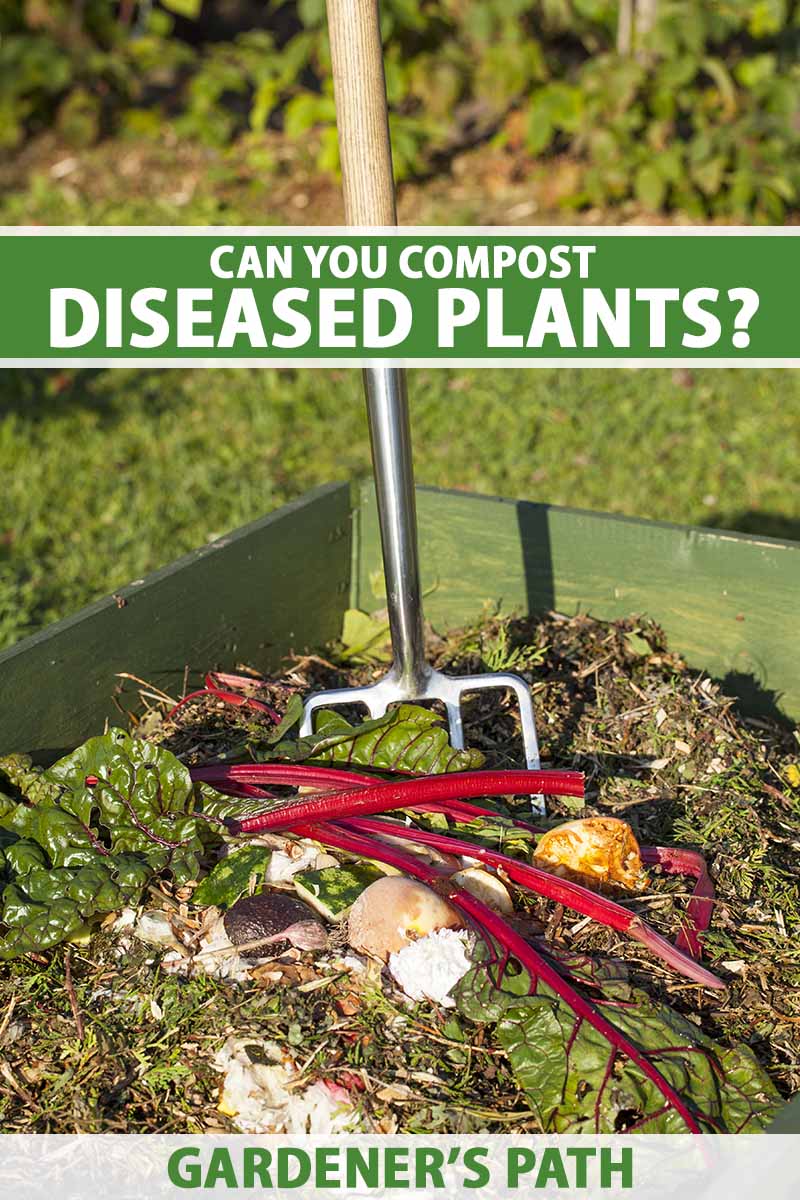
We link to vendors to help you find relevant products. If you buy from one of our links, we may earn a commission.
You can also view compost health from the perspective of live plants – how will plants’ health be affected by using it?
Compost carries valuable resources for crops in your garden or small farm, most notably in the form of nutrients and beneficial microbial life. It also offers overall positive effects on soil health compared to certain other agricultural management practices.
However, it can also carry dormant forms of plant pathogens that cause disease.
Plant diseases caused by pathogens are becoming more variable around the world, partly due to an increasingly fluctuating climate.
In my lab at The Ohio State University, we study species of the water mold Phytophthora, which often produce spores that can overwinter, becoming nearly impossible to obliterate from affected fields.
Many other pathogens evolved similar tactics for persisting outside of hosts. These adaptations can potentially allow pathogens to persist in compost.
On the other hand, some composting methods can help control pathogens. It can quell numbers of pathogens so they’re reduced to undetectable levels, depending on the species.
There are far too many plant pathogens around the globe to cover in a single article! I will tell you about some common species, and whether to address these pathogens with compost.
Here are four broad kinds of pathogens and their general symptoms, followed by ways that compost can change the spread:
Oomycetes
Mildews and many root, stem, and fruit rots are caused by microorganisms called oomycetes. They are related to algae, and are often called “water molds.”
Diseases caused by oomycetes can often look like fungal diseases.
Common oomycetes include Phytophthora, Pseudoperonospora, and Pythium species, which have incredibly wide host ranges around the globe. Most crop species are affected by at least one of these three genera.
Downy mildews are caused mainly when spores splash onto leaves with rain. Stem and root rots mainly occur when plant parts are in contact with contaminated soil.
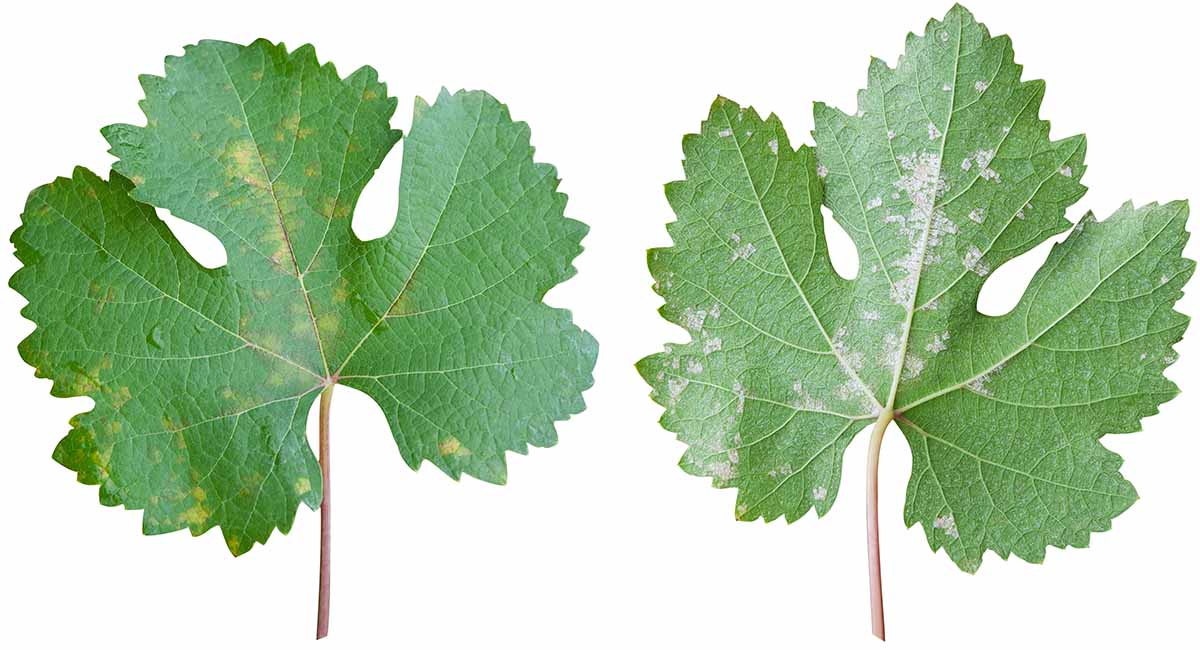
Downy mildews on foliage are visible to the eye because of their sporangia, which appears as a white, fuzzy coating on bottoms of leaves, and corresponding oil spots on the tops of leaves.
Leaf blights from oomycetes cause wilting and brown, necrotic hard spots on leaves. Stem and root rots are usually dark and necrotic, and possibly wet to the touch.
Phytophthora species form thick-walled, overwintering bodies called oospores, which can persist in soils for years, and can even be transmitted via natural water bodies that could possibly come in contact with your garden.

Oospores of other oomycetes have similar durability. These oospores can potentially persist in compost.
Compost systems in more temperate climates are more likely to allow oomycete spores to develop into their overwintering phase, compared to those that are kept at warmer temperatures.
There is research about different methods of suppression of oomycete species.
In a study on rooibos, published by the The American Phytopathological Society, composting suppressed damping off from about half of the oomycete isolates tested, depending on the species and source.
In another study, damping off in cucumbers was reduced when crops were treated with water extracted from chitin-based compost.
Based on those two studies, we can conclude that composting can have a mild to moderate role in reducing oomycete inoculum. Hot is more effective than cold, so if you are adding plant tissue infected by oomycetes, consider covering your pile with plastic or a lid to increase the temperature.
Anaerobic soil disinfestation is shown to be highly effective in eliminating Phytophthora and Pythium.
You can apply this principle to your composting practice by ensuring an anaerobic environment – by covering the pile to increase temperature and keeping it moist.
If you continue to see signs of the same oomycete-caused disease the next season, then it’s best to dispose of diseased tissue instead.
Viruses
Viruses on plants have a unique appearance compared to other microbial pathogens.
Other types of pathogens like water molds, fungi, and bacteria often lead to clear signs of decomposition, and can have specially evolved overwintering forms.
Viruses, on the other hand, can often change their shape and growth pattern, and usually do not develop a dormant body.
Mosaic, mottle, and necrotic viruses are visual categories of plant viruses that can be caused by the same groups of viruses, presenting differently depending on the host genetics.
Mosaic viruses cause a coloration pattern that resembles a web. Usually, mosaic viruses cause chlorosis (yellowing) along the veins in leaves, revealing this weblike pattern. Most viruses also cause unusual curling of leaf edges, and overall misshapen plants.
Two of the most common plant viruses are tobacco mosaic virus (TMV) and tomato mosaic virus (ToMV).
Tobacco Mosaic Virus
TMV is possibly the most common plant virus worldwide, infecting over 300 species.
It is spread mechanically by infected sap that comes into contact with tools, hands, and materials, as well as by seed.
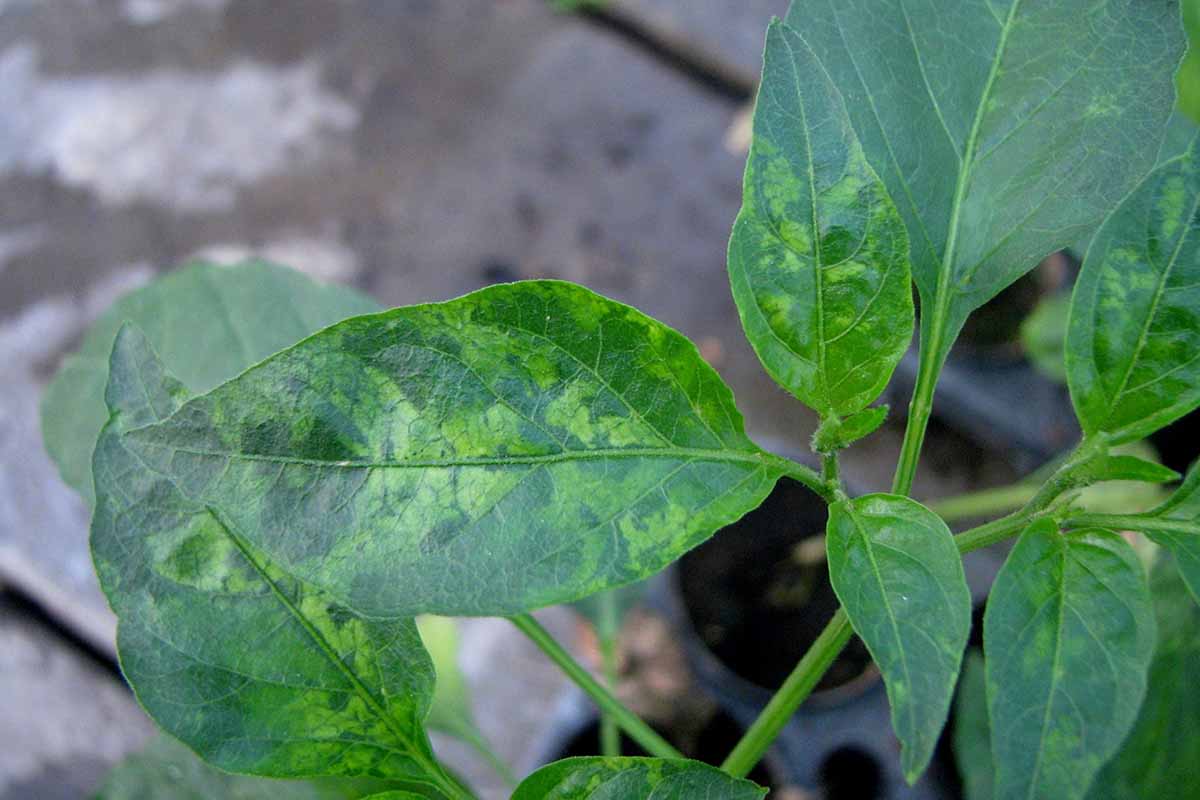
Tobacco mosaic virus is quite stable, and using tissues infected with TMV in compost is not recommended.
Tomato Mosaic Virus
Tomato mosaic virus is also transmitted mechanically and by seed, as well as by aphids and other sap-sucking insects.
Infected specimens generally have stunted growth, curly leaves, and a light grayish-green mosaic pattern on the leaves that can turn yellow. The discoloration appears blotchy, often bordered by leaf veins.

ToMV affects all solanaceous crops like tomatoes and peppers, as well as certain ornamental species.
Luckily, ToMV has been shown to be unstable over long periods of time without a host. It easily degrades after 75 days of composting, even at colder temperatures.
Other Viruses
Depending on the virus, drying of plant material may or may not eradicate it. For example, leaf drying can reduce the infectivity of melon necrotic spot virus (MNSV) but not pepper mild mottle virus (PMMV).
Luckily, composting with irrigation and solarization can often achieve complete eradication of MNSV and PMMV, as well as potato virus Y.
Fungi
Fungal pathogens can present themselves in hugely diverse ways.
Fungi that infect plants can be species that are single-celled, filamentous, or even fruiting bodies like mushrooms.
And their strategies for persisting outside of the host can change from species to species.
Fungal diseases include types of rot, powdery mildew, rust, mold, and wilt.
Fungal Spots and Blights
Leaf and fruit spot are terms used to describe the appearance of fungal diseases as literal “spots” on tissue.
These spots can spread and cause necrosis of tissue, thereby becoming leaf and fruit “blight.”
There are hundreds of thousands of fungal species that cause spotting.
Two common groups of spotting fungi are Alternaria and Anthracnose species. There is little to no research on the survival of Alternaria and Anthracnose in compost systems to date.
Since many fungal spotting species produce overwintering thick-walled structures, it is best to limit placing infected materials in your compost.
Fungal Rots
Rots caused by fungi, such as fruit, stem, or root rot, appear clearly more decomposed and watery than spots or blights. Plants infected with rots will have extensive areas of dead tissue that are often squishy.
Rots can turn into cankers if the plant forms a callus over the affected area.
A common fungal species that causes tissue rots is Rhizoctonia solani. This species has an incredibly wide host range and a worldwide distribution, infecting plants ranging from tomatoes to orchids to trees.
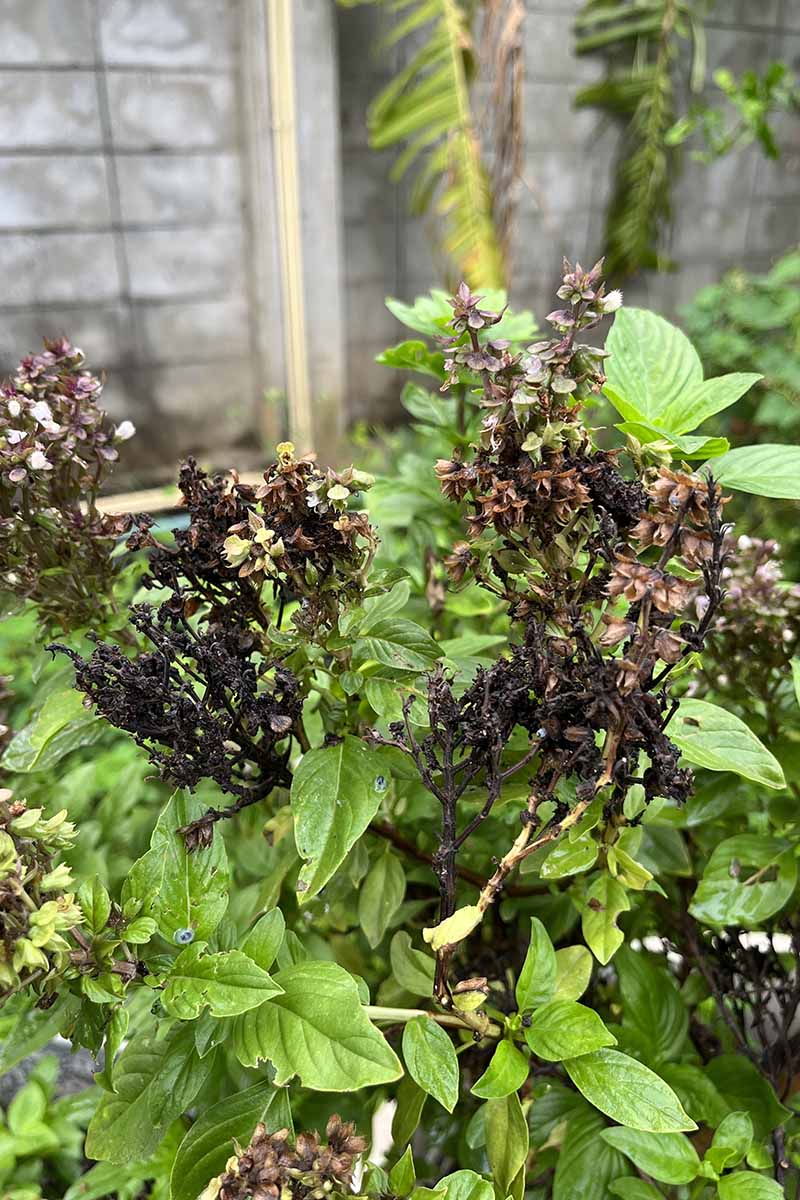
The species produces durable, over-wintering microscopic bodies called sclerotia.
Luckily, several studies suggest that some systems can eradicate R. solani to undetectable levels, as well as for other fungal rotting species, such as Sclerotinia rolfsii and S. minor.
Although, the specific composting methods that are best for suppressing each species may differ.
Fortunately anaerobic methods has been shown to significantly reduce Sclerotinia and Rhizoctonia inoculum.
If you identify fungal rot on your plants, I would try composting them covered and irrigated for several weeks.
Powdery Mildews
Powdery mildews tend to be powdery in appearance, and often appear on the tops of leaves. They can be confused with downy mildew, which is caused by oomycetes.
Powdery mildews tend to occur in drier conditions than downy mildews.
In cucurbits and some other fruits like strawberries, powdery mildew is caused by Podosphaera xanthii.
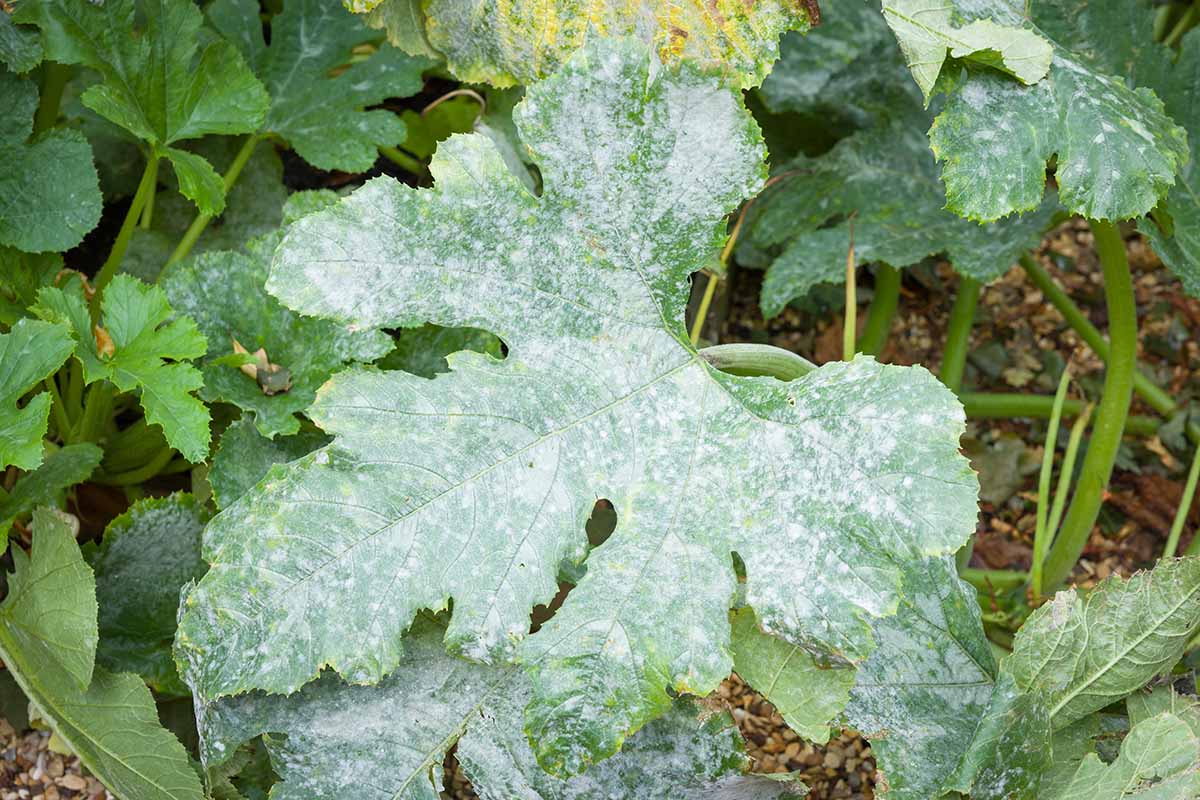
Podosphaera xanthii can produce overwintering spore-like structures called chasmothecia, which persist in soils for many seasons on plant residue.
Unfortunately, there is little research available to date about the presence of this particular pathogen in compost, nor is there for the many other causal agents of powdery mildew on other crops.
It is safer to avoid putting powdery mildew infected tissues in your compost.
You can also try a Trichoderma treatment in your pile. Trichoderma is a genus of fungi known to reduce plant disease. It has been shown to reduce Podosphaera inoculum in soil.
Rusts
Rusts are diseases caused by species of Puccinia and Uromyces, with a notable appearance of raised, small, round, brown bumps on leaves called pustules.
The life cycle of rusts is very complex, and can include up to five different spore stages! Many can even utilize alternative hosts while awaiting the availability of their main host.
Teliospores are very thick-walled, durable overwintering spores that are occasionally produced.
There are few to no studies about the viability of teliospores in compost systems. One rust species, Puccinia horiana, might be able to survive the composting process.
If your plants are infected with rust, I would advise that you dispose of them instead.
Wilts
Wilts are plant diseases with a prominent symptom of, well, wilting!
One of the most common fungal wilts is caused by the species Fusarium oxysporum. This is a filamentous fungus that overwinters via structures called chlamydospores, or even as live hyphae in the soil.
Composting, specifically with green waste biochar, can possibly have a role in reducing viable chlamydospores in the Fusarium–tomato pathosystem.
However, one study suggests that full eradication of F. oxysporum isolates in compost may be difficult.
Another very common wilt is called Verticillium wilt, caused by six species in the Verticillium genus. Cotton, oilseed rape, eggplant, tomato, peppers, and potatoes are commonly affected.
In 2020 at California Polytechnic State University, A Verticillium species was examined in petri dishes for growth with different compost amendments, and it was noted that it moderately suppressed growth of the pathogen.
However, results in the field showed that these amendments did not decrease disease overall.
Therefore, proceed with caution when composting plants diseased with wilt. If you do wish to, make sure to keep the pile wet and covered for several weeks.
Bacteria
Plant pathogenic bacteria differ from fungi, oomycetes, and viruses in that they do not enter actual cells. Instead, they invade the space between cells.
This has caused pathogenic bacteria to evolve hugely diverse methods for infecting their hosts.
Bacterial infections on plants can cause blights, cankers, galls, leaf spots, soft rots, and stem spots.
Here are two common bacterial genera that infect plants, with different strategies for infection and survival: Xanthomonas and Pseudomonas.
Xanthomonas
The Xanthomonas genus contains species of bacteria that can infect over 400 species. These include artichokes, dandelions, cabbage, peppers, rice, bananas, and the list goes on.
One study found that some types of compost were effective in suppressing Xanthomonas campestris pv. vesicatoria in tomato plants, likely due to the beneficial microbes in the process.
In particular, agroindustrial subproducts-based compost was the effective treatment. Sterilized compost did not suppress the pathogen.
Pseudomonas and others
Pseudomonas syringae is one of the oldest-known and most well-studied pathogens, infecting primarily woody plants.
Composting was found to effectively eradicate Pseudomonas syringae pv. actinidiae on kiwifruit plants.
In another study, researchers found that their particular process was effective in suppressing Xanthomonas campestris pv. vesicatoria, Pseudomonas syringae pv. syringae, and another bacterial plant pathogen, Erwinia carotovora subsp. carotovora.
It might be okay to include plant tissues with X. campestris pv. versicataria, P. syringae pv. syringae, and E. carotovora subsp. carotovora in your compost, especially if your pile is hot.
Beneficial bacteria are very important when it comes to quelling pathogenic bacteria in soils.
I would recommend possibly adding Trichoderma or other biocontrol bacterial agents to your compost if you wish to add tissue infected with bacterial disease.
Quell Pathogens with Your Compost
Pathogens that cause plant diseases are numerous, hugely biodiverse, and have different strategies for survival.
There are up to a million pathogen species that can possibly survive in unique ways in your compost.
Peer-reviewed studies can be hard to find when it comes to the persistence of pathogens in compost in particular, and that depends on the species, too.
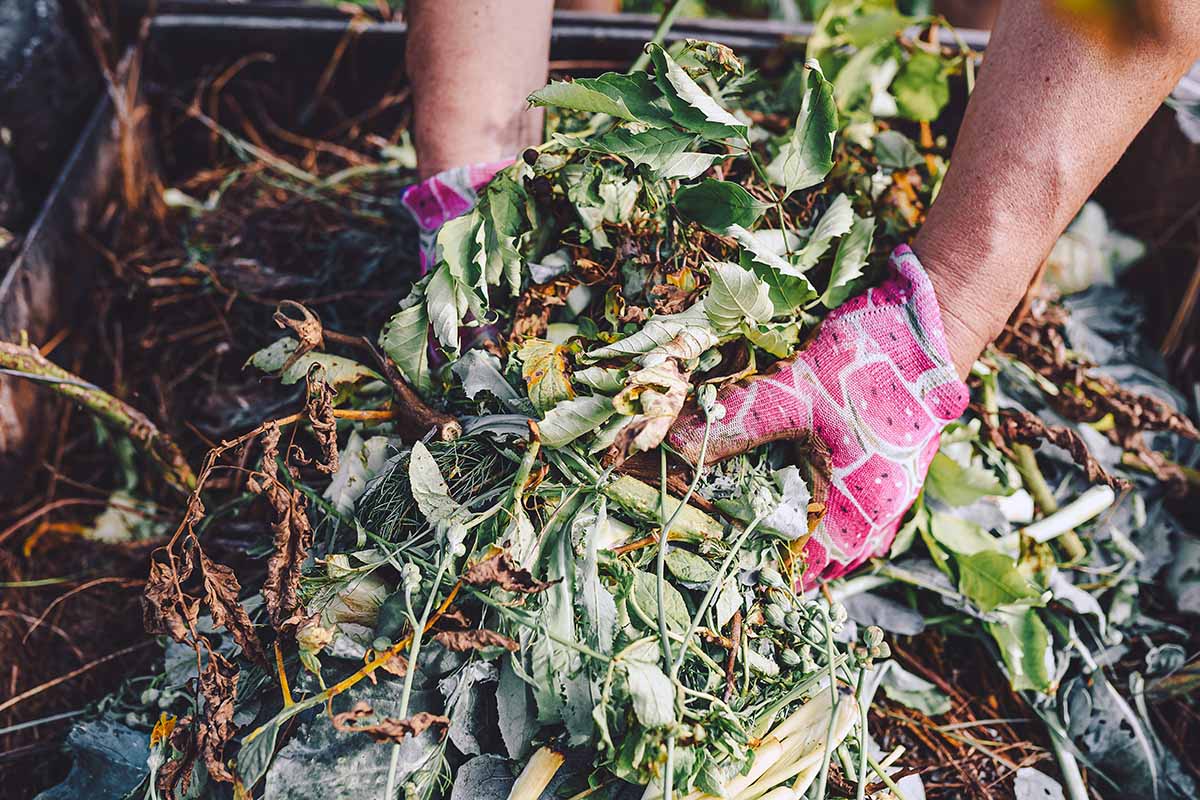
Composting can reduce inoculum of many pathogens, including some oomycetes, viruses, and fungi, at varying rates. There are also pathogenic species that are hardly affected by the process.
However, there is plenty of research on the effectiveness of anaerobic soil disinfestation, which is a process that can be applied to compost. To induce an anaerobic environment, simply keep your pile wet and covered for several weeks.
Therefore, I recommend that you troubleshoot with your own system.
First, try to identify any diseases affecting your plants by consulting the resources here or contacting a regional plant pathologist through your local extension office.
Try to see if there is any literature that explains tested methods for using compost to quell or vector the disease.
If a disease infects your crop, to be on the safe side, you should avoid composting it, but you can also test whether the disease will spread after decomposition.
In most cases, making sure your compost is wet and covered for several weeks in the summer should greatly quell plant diseases in your garden.
You can select control plants that you treat with compost that lacked the infected material, and compare with your plants that are treated with that which contained infected material.
If you have a persistent, multi-season problem with the same disease, consider wiping out any source of inoculum by eliminating diseased plants, collecting and disposing of plant litter, and starting over by composting non-infected materials.
Have you ever tried composting diseased plant tissue? What was your experience? Let us know in the comments section below!
And for more information on composting and soil health, check out these guides next: